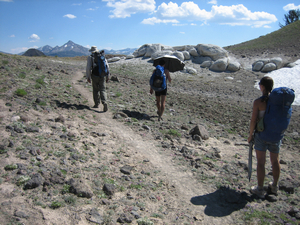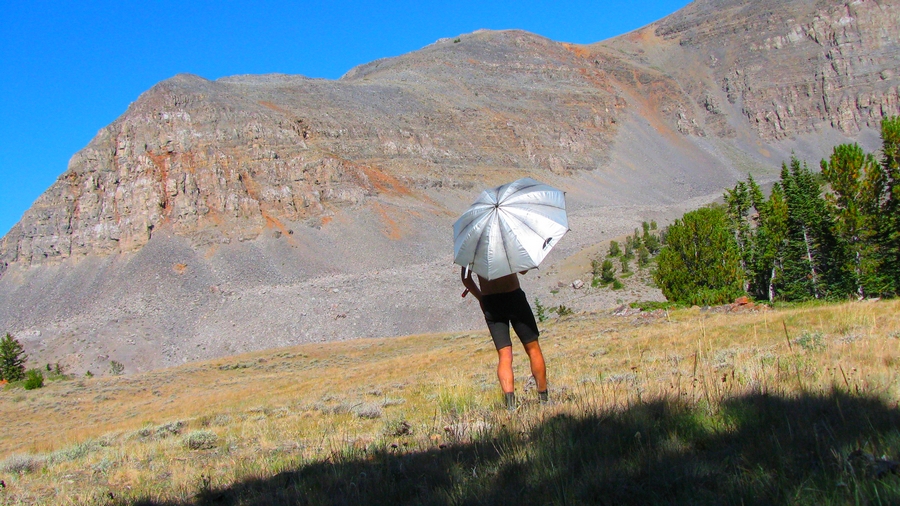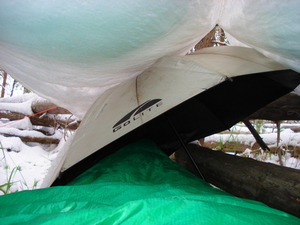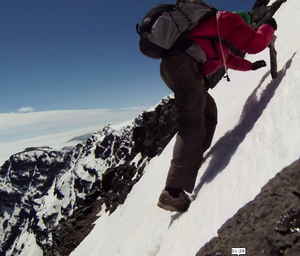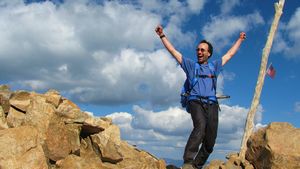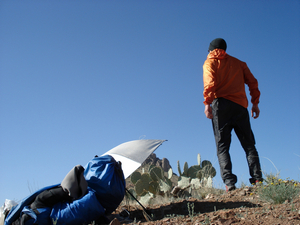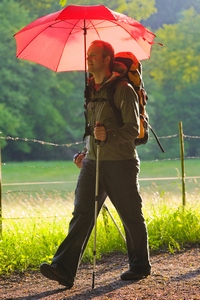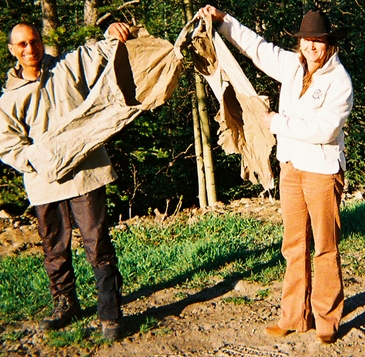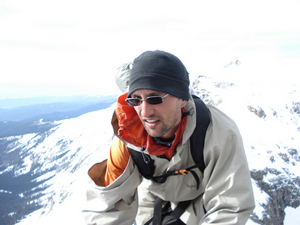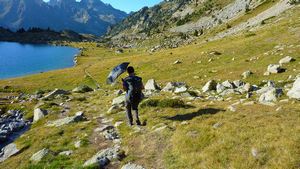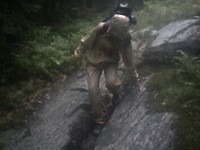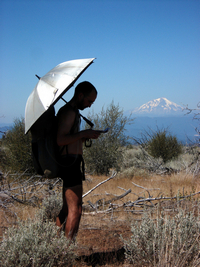
When I'm backpacking, hikers often ask, "Why are you carrying an umbrella?"
What they're really thinking is: "Hey moron, what's with the stupid umbrella?"
An umbrella seems out-of-place in the wilderness. It's for city folk, not for macho backpackers. However, hiking with an umbrella is not as foolish as it looks.
I've used umbrellas on the Appalachian Trail, Pacific Crest Trail, and Continental Divide Trail. An umbrella has protected me also during treks across Costa Rica's Osa Peninsula jungle, Slovakia's Tatra Mountains, and Ukraine's tallest peak.
They've also served me well during my trek across the Pyrenees and El Camino de Santiago. Lastly, I've been using Gossamer Gear's Liteflex Hiking Chrome umbrellas extensively during my 5-year trip to Africa.
I've also used rain jackets. Indeed, I adore my awesome ExOfficio rain jacket. However, in general, I find an umbrella superior for most backpacking and hiking adventures. Here are 10 reasons why...
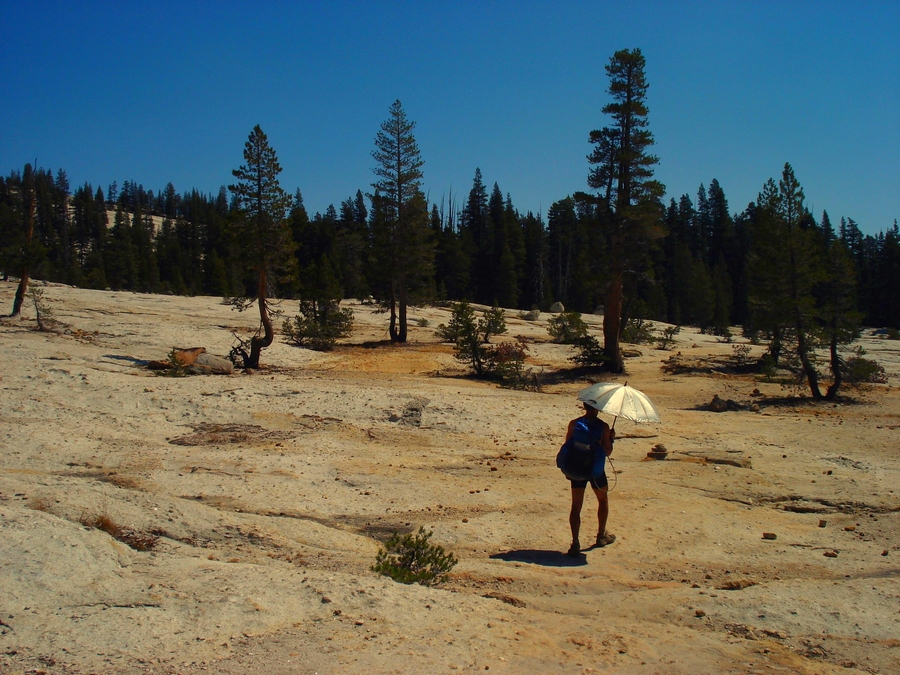
Listen to this article below!
About the photos on this page
1. When you mouse over the photos (especially the thumbnails), cool things happen.
2. If you're wondering why there aren't any photos of me in the rain, it's because nearly all these photos were done with a self-timer (since I was alone), and I don't like putting my camera in the rain to take a self-timed photo.
1. Umbrellas protect backpackers in rainstorms
Let's start with the obvious: umbrellas work. They stop the rain. If they didn't, they wouldn't sell throughout the planet. As obvious as this is, some backpackers act like umbrellas just don't work.
But if they didn't work, then Yankee wouldn't buy 33 million umbrellas every year. That's remarkable: 1 in 10 Yanks buys an umbrella each year.
Why?
Because umbrellas are one of the most successful ways of protecting humans from precipitation.
2. Umbrellas provide more ventilation than any rain jacket
I usually don't backpack with a rain jacket because I find that no rain jacket offers as much rain protection and ventilation as an umbrella. The ventilation is important because it postpones overheating.
For example, on the Appalachian Trail, my hiking partner Lisa wore a rain jacket, but by the time she would get to the top of a mountain, she would be soaked—in sweat, not rain. That wetness would help take her down the path of hypothermia because of the cold winds at the summit.
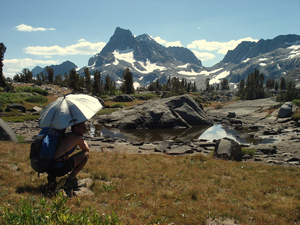 An umbrella helps regulate your temperature because it lets the heat that your body generates evaporate quickly. Even “breathable” rain jackets trap a significant amount of heat.
An umbrella helps regulate your temperature because it lets the heat that your body generates evaporate quickly. Even “breathable” rain jackets trap a significant amount of heat.
With an umbrella, as you near the top of a mountain, you can add a layer of clothing before your body starts to cool during the descent.
3. Umbrellas weigh less than most rain jackets
At 230 grams (8 oz), a Gossamer Gear Lite Flex Chrome Dome umbrella weighs about nearly half as much as a typical “breathable” rain jacket. Thru-hikers are fanatical about minimizing their pack weight, so this is yet another good reason to use an umbrella for rain protection.
Lisa discovered that I was staying drier than she was, so after New Hampshire, she sent her rain jacket home and used an umbrella for the 12 remaining states on the Appalachian Trail.
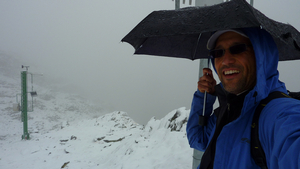 4. Umbrellas work in snowstorms too
4. Umbrellas work in snowstorms too
Snow effortlessly flakes off an umbrella, thereby protecting you. In Eastern Europe, people often use umbrellas even in the snowy winters.
Of course, if you're going to do winter camping, then a rain jacket (or a parka) is probably better than an umbrella (see below to understand why).
Still, for a freak summer snowstorm, umbrellas do the job.
5. Umbrellas excel during off-and-on rain periods
When it's raining on and off all day, the poor rain jacket wearer has to go through a complex, time-consuming ritual every time he removes or dons his rain jacket.
Meanwhile, an umbrella user can effortlessly whip out or stow her umbrella during the intermittent rain (the photo below shows how I stow my umbrella behind my back because it's comfortable and easy to access).
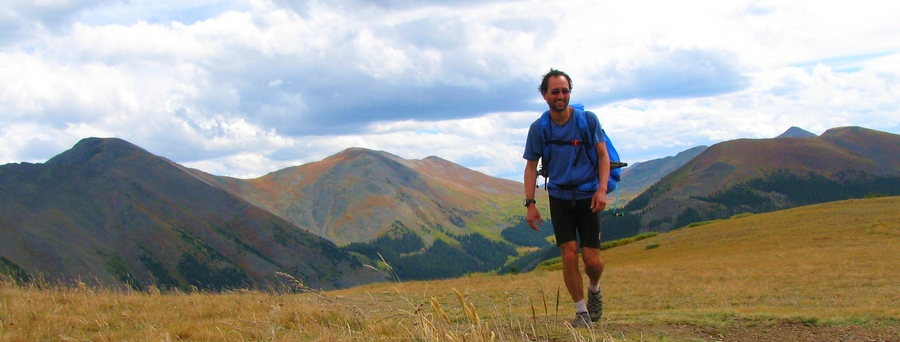
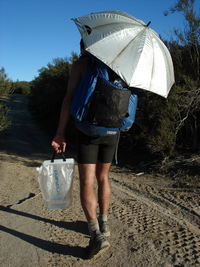
6. Umbrellas protect you against the sun
What did your mom tell you to do when it was cold outside?
"Put on a hat!"
OK, my mom didn't say that either, but she should have.
It's smart to put on a hat when it's cold. You lose about 15% of your body heat through your head. And that's precisely why I prefer an umbrella over a sunhat when the sun is beating down on you. The sunhat just traps heat in, offsetting most, if not all, the benefits of the limited shade it delivers. Hats give you limited shade (barely covering your face unless it is wide-brimmed, which then could get blown away by a gust of wind).
An umbrella gives you a ton of shade (usually down to the knees) and lets heat escape from your head, keeping you cool. Moreover, you can shed layers and walk around shirtless (or a sports bra if you're a woman) and enjoy the airflow and shade.
Did you know? We sometimes make a distinction between an umbrella and a parasol (which means "for the sun" in Spanish). However, the word umbrella comes from the Latin word umbra, which means shade. Indeed, the first reason someone invented an umbrella was to protect against the sun, not the rain. So don't feel strange using an umbrella to protect yourself from the sun―that's its original purpose!
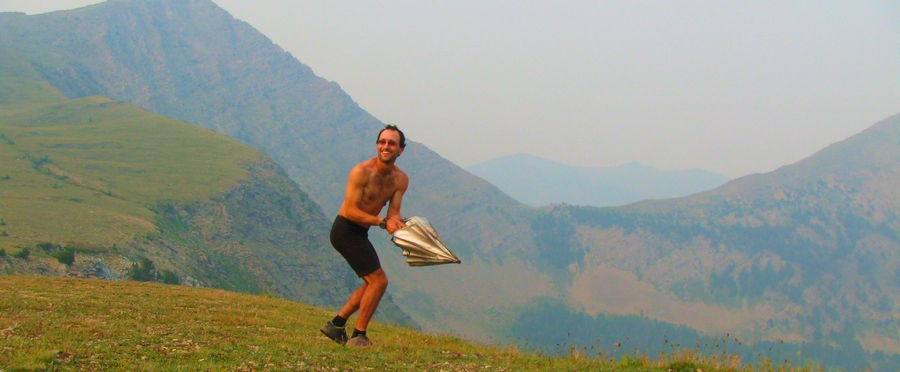
7. The umbrella offsets its weight penalty
Lightweight backpackers whine about the umbrella adding weight to their minimalist gear list. However, hiking under shade all-day long will dramatically lower your water needs, especially on hot days. If you don't have an umbrella, you'll need to carry at least an extra liter of water to make up for the sweat loss. You'll also have to carry more sunscreen to protect a greater portion of your body. All this extra weight will be more than an umbrella.

8. Umbrellas provide a micro-shelter
- A privacy screen: As thru-hiker Christine Haffner said, "One of the biggest reasons why I was sold on the umbrella: it offers a place to pee behind. This is most beneficial for women, but also for men. Especially in really crowded areas where you cannot find a place to pee, you just find a tree to block one side of you, and the umbrella to block the other side. There is really no other piece of backpacking gear that will provide this for you. SOLD!"
- Map and meal cover: When it's pouring rain, it's awkward to study a map or to prepare a meal, but an umbrella's canopy makes it much more pleasant.
- Plug a tarp hole: If rain is sneaking into your tarp (because you did a sloppy setup), then an umbrella can plug a hole (enlarge the photo on right).
- Windscreen: Need to light a fire? Want to increase your stove's efficiency by blocking the wind? An umbrella can help.
-
A poor man's pack cover: With a 40-inch canopy, you can drape half of the umbrella over the top of your backpack, providing it with partial cover, while still protecting you.
- Eyeglass protector: If you wear eyeglasses, umbrellas let you gaze around easily without getting your eyeglasses wet. A rain jacket's hood forces you to stare at the ground or get your eyeglasses wet.
- A "bug net condom": Lint, whom I hiked with for 4 days on the CDT, used his umbrella to create what he called a "bug net condom." He would drape his bug netting over the umbrella while he was sleeping or eating a meal in the company of bugs. (Thanks Bobcat for the reminder.)
9. Umbrellas can be an anchor point for your tarp or shelter
I've sometimes used an umbrella as an anchor for my tarp when trees are lacking (as the photo below illustrates).
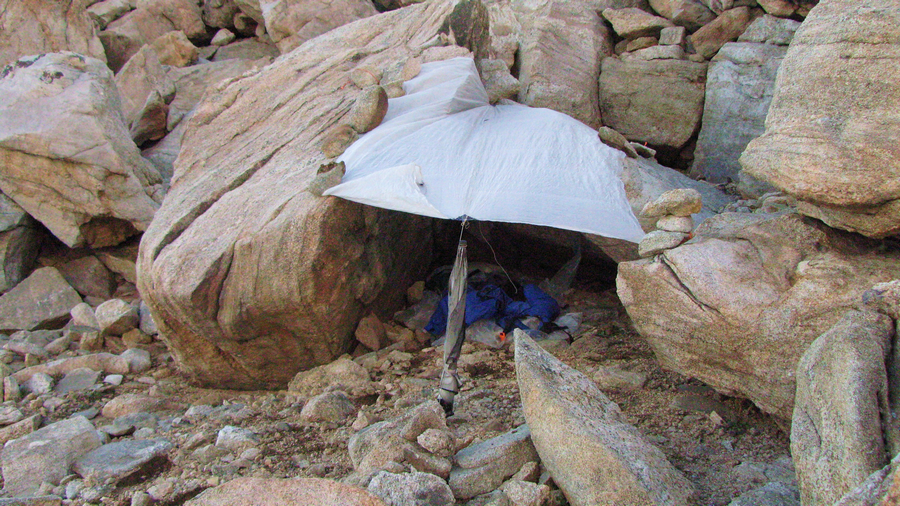
10. Umbrellas can be an all-purpose stick
Umbrellas can be a:
- Poor man's ice ax (enlarge the photo on right).
- Short stick to balance on when fording a river.
- Way to defend yourself against a snake.
- Great way to smack someone who says you're ridiculous for bringing an umbrella into the woods.
Although those are 10 great reasons to use an umbrella while hiking or backpacking, critics still have questions. So let's answer them...
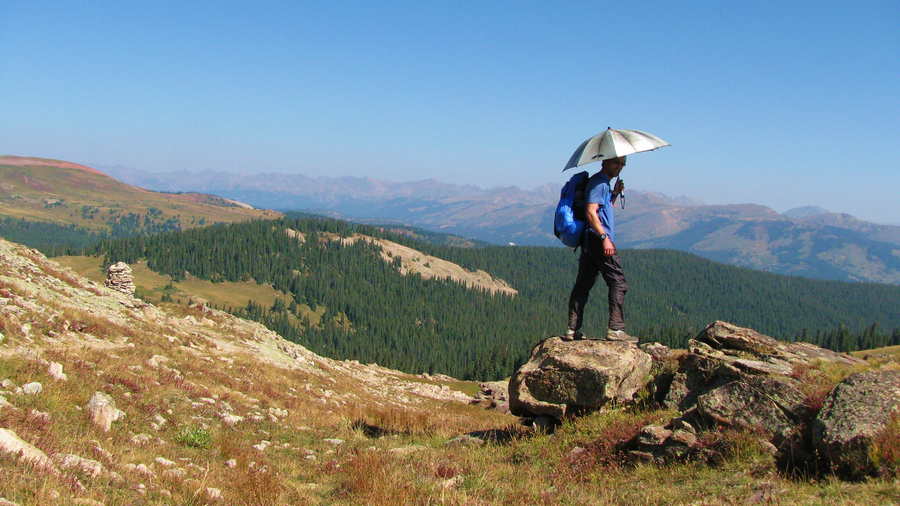
10 frequently asked questions about carrying an umbrella while hiking or backpacking
Let's address the top 10 questions people have about backpacking with an umbrella.
1. But don't you need a jacket anyway?
Probably, but unless you're hiking in freezing temperatures, an ultralight (sub-4 oz) jacket is good enough. Despite all the advertising, there's no such thing as a truly breathable rain jacket. Breathable shell jackets are much more breathable and lighter than rain jackets. My ultralight jacket weighs 3.5 ounces. The lightest rain jackets weigh 8 ounces, but they suck in truly rainy weather. To get an excellent rain jacket that will keep you dry in a sustained downpour, you'll need something that weighs at least 12 oz and probably more like one pound, like my ExOfficio rain jacket.
Compare that to an umbrella (8 oz) + softshell jacket (3.5 oz) = 11.5 oz. A good rain jacket will weigh 25-50% more than an umbrella + softshell jacket combo.
What's the point of a softshell jacket? It protects you against a little bit of wind, rain, and cold. It also protects you against mosquitoes. If you must have something to keep you warm, a fleece or insulated jacket will do a much better job than a rain jacket. If you need something to keep you dry, an umbrella will trump a rain jacket, especially if it's warm enough to make you sweat with the rain jacket on.
2. Do your arms get tired holding the umbrella?
I never get tired of holding the umbrella and I often have it deployed for 10 hours a day. There are two secrets to not getting tired:
- Get a light umbrella (300 grams / 10 ounces or less).
- Lean the umbrella against your body and switch hands occasionally.
Often the angle of the sunlight allows you to rest the umbrella shaft against your shoulder. While you still have to hold the handle, the weight is distributed against your body/chest/shoulder, so it doesn't feel heavy at all.
When the sun is setting in front of you, you have little choice but to hold it out in front of you (see photo below). This is the most taxing position, but it rarely lasts long since the sun does set, trees block it at that angle, or the trail changes direction.

If you do get fatigued, just switch hands. Let's say the sun is hitting your right side and you're tired of holding it in your right hand. I'll hold it in my left hand and have the shaft rest against the back of my neck so that the canopy is still sheltering my right side from the heat and UV. It gives my right hand a break and since most of the pressure rests on my neck, my left hand doesn't get tired at all (and the umbrella is so light that my neck doesn't tire either).
3. What about fixing the umbrella on your backpack so you don't have to hold it?
Some hikers want to prop their umbrella on their pack so that they don't have to hold it and can continue using their trekking poles.
However, it's a bad idea because the umbrella is fixed. Since the path of the trail and the sun are constantly changing, you need to adjust the umbrella to provide optimum shade. If you're going to carry a half-pound piece of gear, you might as well use 100% of it, not 25% of it.
Unless the sun is directly overhead, propping the umbrella will provide sub-optimum coverage. If the sun is at an angle, then an umbrella that is pointed straight up is only protecting your head from the sun, whereas a tilted umbrella can cover 80% of your body (the only part of my body that was exposed was just below my knees). If you're just interested in protecting your face from the sun, just get a wide-brimmed hat.
Still, if you must try this, experts tell me an easy way to rig up the umbrella is to use a Camelbak Tube Trap. However, I think these four solutions are even slicker. Here's a cheap do-it-yourself solution. Lastly, see my video review of the Hunter's Tail UV Umbrella Hat:
4. What about umbrellas with reflective canopies?
I have tested umbrellas with a reflective material side-by-side ones that have a black canopy. I've put a thermometer under each canopy to see if I could detect a difference. My tests were not scientific, but I was disappointed with the results. Yes, the reflective umbrella is cooler than the black one. However, the difference is small, just a couple of degrees.
On the other hand, a subtle difference adds up over time. If a couple of degrees saves you from tipping you into heatstroke-land, then it's worth it. Perhaps it's just psychological, but it sure feels cooler under a reflective canopy.
Despite the minor temperature difference, I still recommend the reflective canopy. It's only $10 more and the umbrella will last for many years. You'll appreciate those extra degrees when you're walking across a hot desert.
One thing is clear: any umbrella has a dramatic effect on shielding you from the hot dry sun. When it's blazing hot outside, it's better to have ANY umbrella than just to have a measly sunhat that traps all the heat in your head.
When I was traversing 44 kilometers (20 miles) of exposed beach in Costa Rica, I bumped into a red man. He was sunburned and said that he had a heat stroke the day before after walking just 5 km. When he saw me, he said, "Duh! Now that's what I should have taken!"
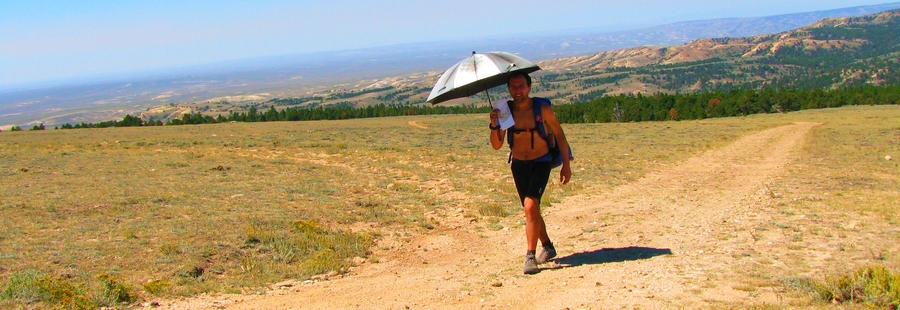
5. So if umbrellas are so great, why don't hikers use them more often?
-
Some hikers can't let go of their trekking poles. Himalayan Sherpas carry far more weight than the typical backpacker and their joints don't let them down. If you lighten your total pack weight to under 10 kg (22 pounds), then you may discover that trekking poles are no longer necessary. Try it. Drink so much water that your pee is always clear.
-
Backpacking gear manufacturers don't want you to consider umbrellas. A nice rain jacket costs $300. A nice umbrella costs $30. You don't need a Harvard MBA to figure out why the backpacking industry doesn't want to encourage hikers to use umbrellas. If umbrellas would somehow cost $400, then more manufacturers would promote their utility.
6. But don't umbrellas break?
Good ones are hard to break. The backpacking-specific umbrellas that I list at the end of this article are different than the standard $5 collapsible umbrella. The reason so many people believe umbrellas are weak is that they've only used cheap umbrellas. It's like someone believing that all cars are slow, but they've never driven a Ferrari.
And so what if it breaks? Everything can break. Your tent poles can break. Your stove can break. Your inflatable pad can puncture. Your sleeping bag can get soaking wet. Your backpack's straps can snap.
And yes, even your rain jacket can break. Yup, the jacket's zipper may fail. Or you fall and rip it. Or get it snagged. Or just simply wear and tear and destroy it. See my video below for proof:
Let's imagine your umbrella breaks. First of all, unless a tornado blows it out of your hand and carries it into the heavens, you'll still have a broken umbrella. And just like a ripped rain jacket is still useful, so is a broken umbrella.
During my Pyrenees hike, for example, a spoke on my $5 umbrella broke. I could still use it for 40 more days of backpacking across Spain. Sure, it wasn't as effective as when it was new, but it was 80% effective at stopping the sun and rain.
When I was trekking in Eastern Europe's Carpathian Mountains, my cheap umbrella completely broke apart. However, it was still useful, even though it could not stay in the locked open position. I just rested the umbrella's canopy on my head and it still covered me somewhat effectively.
Moreover, when an umbrella breaks, it's similar to when other gear breaks: it usually doesn't completely fail in one second. A small tear will appear. One or two spokes will break. It's not like the entire canopy will suddenly disappear in one gust and leave you with just the umbrella's broken skeleton in your hand.
Nevertheless, let's consider the Mary Poppins Nightmare: the umbrella flies away. Are you going to die?

Hell no. You might not even get wet.
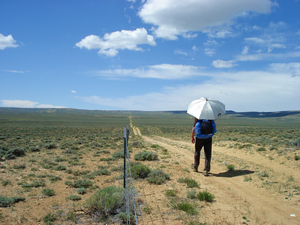 First, assuming you're carrying a tarp/tent, you can just camp and wait out the rainstorm. If you want to keep moving, then wrap yourself up in your tarp, your tent's fly, or your groundsheet. Voila, instant poncho! It's not as elegant as an umbrella, but you ain't gonna die and you may not even get that wet.
First, assuming you're carrying a tarp/tent, you can just camp and wait out the rainstorm. If you want to keep moving, then wrap yourself up in your tarp, your tent's fly, or your groundsheet. Voila, instant poncho! It's not as elegant as an umbrella, but you ain't gonna die and you may not even get that wet.
But what if you're on a day-hike and you don't have any of those items? You've got an emergency space blanket with you, right? If don't, you should. It's feather-light and can be a great waterproof barrier.
However, if you don't have one, then you're probably not that far from safety—it's a day-hike, after all. Worst case: you make a shelter like Survivorman.
The critic retorts, "But I ain't gotta worry about such worst-case scenarios with my rain jacket—ain't no way that thing is gonna blow off my back and fly away!"
True, but it can still vanish.
How?
If it's strapped to the side of your backpack, it can fall out. Or you can accidentally leave it behind at a rest stop or campsite. The point is that rain jackets aren't immune to catastrophic failure either.
The bottom line is that if your umbrella breaks, it is probably still going to be at least marginally functional long enough to get to civilization. Even if your umbrella flies away, it's not the end of the world. Lastly, remember that it's extremely hard to break a Gossamer Gear umbrella, especially if you're handling it properly. Which brings up . . .
7. How do you deal with wind-driven rain?
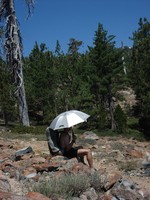 Dealing with wind-driven rain is pretty easy. Just hold the shaft with two hands and let the canopy bend against your body. No matter how hard that rain/wind comes, the canopy won't snap because it's bumping up against your body.
Dealing with wind-driven rain is pretty easy. Just hold the shaft with two hands and let the canopy bend against your body. No matter how hard that rain/wind comes, the canopy won't snap because it's bumping up against your body.
In extreme conditions where I fear the wind (100+ kph), I will press the release button so that the umbrella is on its way to collapsing (as if I were going to stow it away). If a massive gust comes (one that could theoretically snap the umbrella), then all that will happen is that the umbrella will collapse into the stowaway position. It won't snap.
Finally, the most likely situation that breaks an umbrella is not rainstorms. It's when it's sunny and windy. The sun might be on your right and the wind comes from your left. That's when you're most likely to break the umbrella because you'll be tempted to block the sun on your right and a gust comes from the left that inverts your umbrella.
In a rainstorm, on the other hand, the wind and rain always come from the same direction, so they're no debate about where to face the umbrella.
When it's sunny, remember to ignore the sun if it's windy. Make the umbrella face the wind. You'll always find an angle that provides at least 50% sun protection without risking inversion. It takes a bit of practice. I've inverted my GoLite umbrella a few times, but then I just pop it back into position without any side-effect.

8. What about collapsible umbrellas?
Although I've used them, I'm skeptical of any collapsible umbrella because the mechanics involved either add weight and/or decrease strength.
Non-collapsible umbrellas are easy to stow behind your back or in your backpack.
9. When should you NOT use an umbrella?
- When you're backpacking in snow. You get 50% of the sun's impact from the reflectivity of the snow itself. While using an umbrella isn't completely useless, it is only half as effective as it is when you're on snow-free ground.
- When daytime temps are close (or below) freezing. At such cold temperatures, most people will want more than a feather-light wind jacket. A rain jacket offers that extra layer, which is useful when it's cold. Umbrellas excel in most 3-season backpacking when it's not near (or below) freezing. If it's above 5 degrees Celsius, I'll carry an umbrella.
- When you expect to need both hands for extended periods. When you're traveling through snow all day long, you'll probably need an ice ax. If it's raining (or snowing) while you're traversing a steep icy slope, it's cumbersome (and dangerous) to hold an umbrella at the same time. You'll have the same issue if the trail is so steep that you need to use your hands.
However, don't overestimate how many minutes per day you'll be spending doing such acrobatics in the rain.
First of all, when confronted with such a challenge, there's a good chance that it won't be raining, so just put away the umbrella, use your hands, and enjoy some sun. Second, because such moments are usually brief (taking a few seconds or a few minutes), your wind jacket will provide enough protection from the rain.
I went through the Mahoosuc Notch while it was raining. That's one mile of trail that requires you to use your hands most of the time as you negotiate between boulders. A rain jacket would have been better, but I still could use my umbrella most of the time. I just stowed my umbrella and let my featherlight wind jacket get a little wet while I climbed a rock.
On the other hand, I certainly didn't take an umbrella up Mont Blanc!
10. Should you ever have a rain jacket AND an umbrella?
Yes, if you're hiking in someplace like the rainy Olympic National Park, then having two layers is nice. There have been a few times where I've been in four days of truly nonstop rain. In such conditions, it's practically impossible to stay dry unless you're wearing one of those thick yellow fisherman's outfits. However, having a rain jacket + umbrella combo will help.

I'm sold, where can I buy one?
Here are the best choices:
- Gossamer Gear offers the LiteFlex Chrome umbrella (my top recommendation)
- Sea to Summit's umbrellas
- Montbell's Sun Block umbrella
- SnowPeak's $45 ultralight umbrella
- EuroShrim's trekking umbrella (same as the birdiepal umbrella) - see video below
- Umbrella hat for those who love trekking poles.
- For a rain jacket: ExOfficio's Rain jacket
I search for and celebrate innovative companies. That's why my sponsors are all innovators in their field. Although GoLite made a great leap in umbrella innovation, the new senz° umbrellas tried to take umbrella technology a step further. Although they don't target the backpacker or hiker, it seems that it would be an ideal market segment for their wind-resistant umbrellas. Unfortunately, both of their umbrellas failed me in 2016 and 2017, while I was trekking in Africa. I even took it up Kilimanjaro. I can't recommend it yet. I've given them feedback and they promise a new model in 2020 that will meet my specs. I'll review it then.
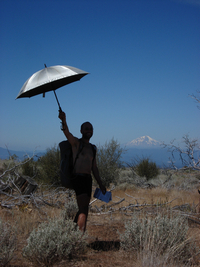 Conclusion
Conclusion
Many backpackers don't consider using an umbrella because they don't want to look like a wuss. It's like a professional wrestler wearing a pink outfit. Backpackers have an independent, I-defy-the-world spirit. However, some are still worried about how they look. If you're one of these, console yourself that some of the most extreme backpackers use umbrellas.
For those who are wedded to their trekking poles, I encourage you to have an affair with an umbrella. Just try it. Start with day hikes. Rediscover your bipedalism. ;)
On the other hand, most hikers think I’m nuts.
Although I encourage you to try using an umbrella, what’s even more important is that you hike your own hike and use whatever rain protection makes you happiest.
Share your experiences with umbrellas in the wild in the comments below.
